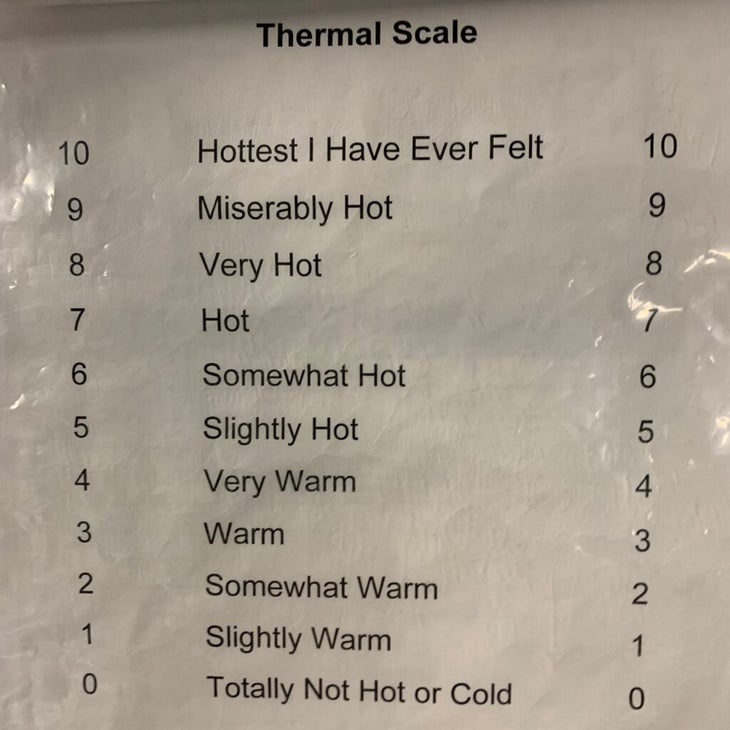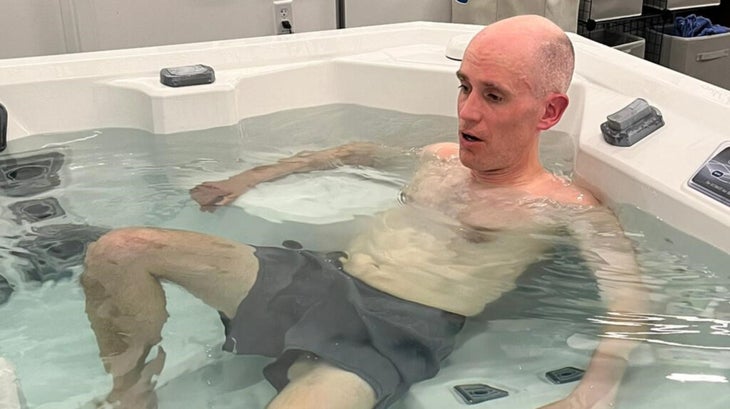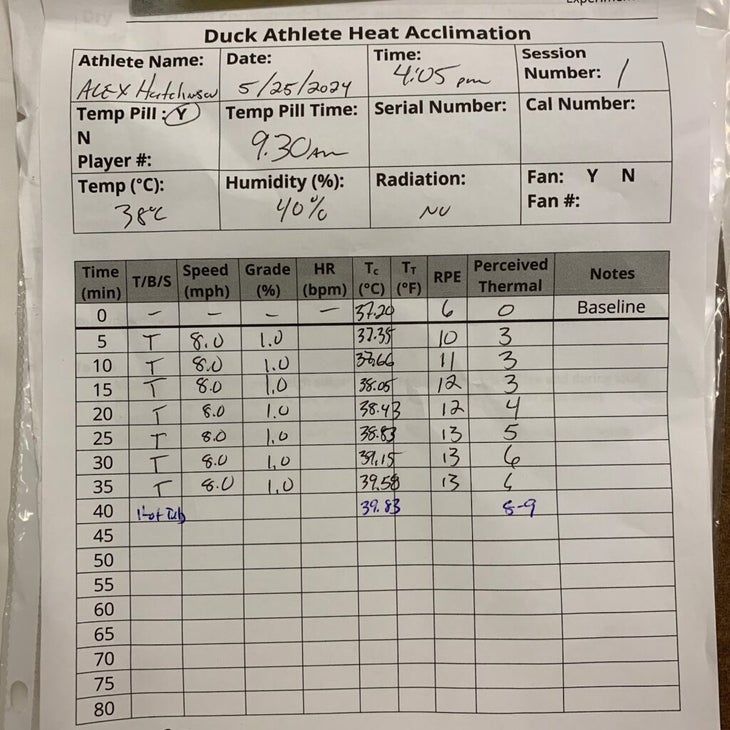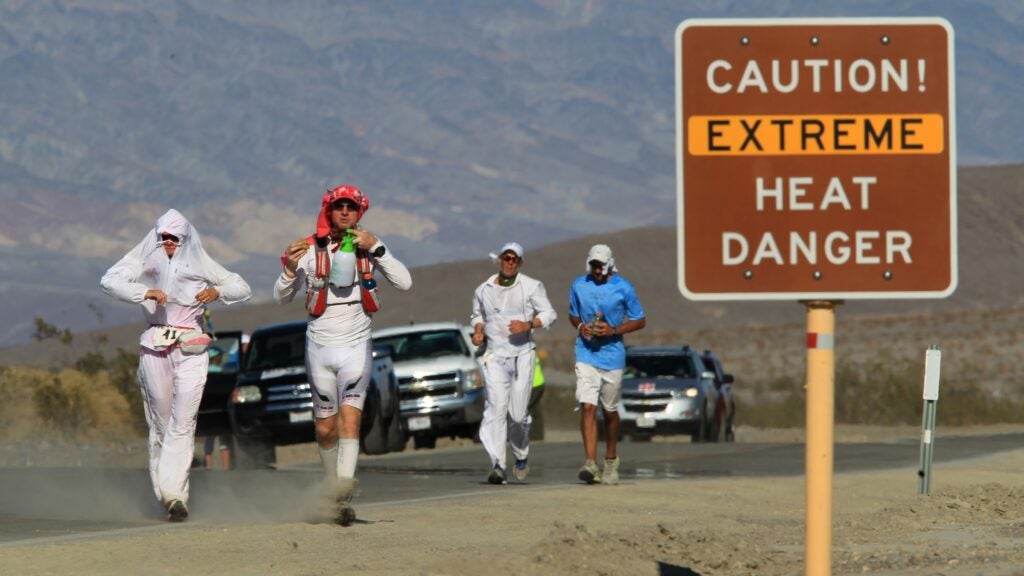No products in the cart.
Outdoor Adventure
Running in the Heat? Here’s the Best Way to Train
After a few pleasant hours sitting in the sun watching the Prefontaine Classic in Eugene, Oregon last month, I headed down into the bowels of Hayward Field for a grueling test for running in the heat. Chris Minson, a professor of human physiology at the University of Oregon, had invited me to try the heat adaptation protocol he has developed for elite athletes from the university and from local pro teams like the Bowerman Track Club. I’ve written about Minson’s research several times, so experiencing the protocol first-hand seemed like a good idea… at the time.
Heat is a big deal in sports these days, and it’s only getting bigger. In recent years we’ve had major events like the world track and field championships in insanely hot places, like Qatar, where the marathons had to be started at midnight. But summertime in Eugene (where the Olympic Track Trials will take place later this month) and Paris (where the Olympics will be held) can also be sizzling. Over the past decade, heat preparation has gone from a nice-to-have to an absolute necessity for top athletes. The details of how to prepare remain more art than science, though, so I was interested to see how Minson put theory into practice.
The Goals of Heat Adaptation
Back in the 1920s and 1930s, scientists developed the first heat adaptation protocols for workers in South Africa’s sweltering gold mines. The gold standard for heat adaptation evolved from that work: spend at least an hour a day exercising in hot conditions, and after 10 to 14 days you’ll see a bunch of physiological changes. Your core temperature will be lower, your blood volume will be higher, you’ll begin sweating and dilating your blood vessels at a lower temperature threshold, you’ll sweat more, and so on. Put it all together and you’ll be able to stay cooler and run faster in hot conditions.
In fact, there’s even evidence that this type of heat adaptation can make you faster in moderate weather, perhaps as a result of the extra blood plasma. In the lead-up to the 2008 Olympics, Minson was working with American marathoner Dathan Ritzenhein, helping him prepare for the expected hot conditions in Beijing. But he started to worry about what would happen if it wasn’t hot: would all the heat training actually make Ritzenhein slower? Minson and his colleagues ran a study to find out; the results, which they published in 2010, suggested that heat adaptation helps even in cool conditions. That’s the study that really kicked interest in heat training into higher gear.
The problem with the classic approach, though, is that training for an hour in hot, muggy conditions is exhausting. If you’re trying to do a hard workout, you won’t be able to hit the splits you want. If you’re trying to do an easy run, it’s going to take more out of you than it usually does, potentially compromising your next hard workout or raising your risk of overtraining. So how do you get the benefits of heat adaptation without tanking the rest of your training plan?
The Modified Minson Protocol
Minson’s Exercise & Environmental Physiology Lab at the University of Oregon, which he co-runs with fellow physiologist John Halliwill, is located in the Bowerman Sports Science Center, a state-of-the-art facility located under the northwest grandstand of Hayward Field. The key piece of equipment, for my purposes, is an environmental chamber that can take you down to 0 degrees Fahrenheit or up to 22,000 feet of simulated altitude, deliver simulated solar radiation, or blast you with wind. For my heat run, Minson set the dials to 100 degrees Fahrenheit and 40 percent humidity.
Earlier that day, Minson had given me a thermometer pill to swallow, which would enable him to wirelessly track my core temperature as the run progressed. “I’ll need that back,” he warned me, poker-faced. Fortunately, he was joking.

Before I entered the chamber, I peed in a cup so that Minson could check my urine-specific gravity, the ratio of how dense your urine is compared to water. I clocked in at 1.025, marginally above Minson’s threshold of 1.024 for mild dehydration. I blame it on having spent a few hours sitting in the sun watching the track meet. Then he checked my weight, so that he’d be able to figure out how much I sweated during the test.
When I stepped into the chamber, wearing nothing but shorts and running shoes, I could feel the blast of heat, but it wasn’t too oppressive—like a really hot day at the beach but under an umbrella. I started with a five-minute warm-up at a slow pace, gradually ramping up until I hit 7:30 mile pace. Then the formal protocol started: 30 minutes at that pace.
What It Felt Like to Run in the Heat
The pace was self-chosen; Minson refused to tell me the pace I “should” run. The goal was to settle in at an effort that I could comfortably maintain for half-an-hour, and that would get me hot enough to trigger adaptations—a core temperature of about 101 degrees Fahrenheit is thought to be about right—without overshooting and roasting myself. Most of the elite runners he works with end up choosing paces between 7:00 and 8:00 per mile. I slotted myself in the middle of that range—which, let’s be honest, was a dumb thing to do for an aging non-elite runner.
Still, the running itself felt easy to me. Every five minutes or so, Minson had me rate my perceived effort on the Borg scale, which runs from 6 to 20, and also rate how hot I felt. For this, he used his own 0 to 10 thermal scale.

I started out at the effort of 10 (“very light”) and thermal sensation of 3 (“warm”). After 15 minutes, my effort had crept up to 12 (“somewhat hard”), but my thermal sensation was still 3. By this point I was sweating up a storm, watching with interest as my splatters of sweat made a distinctly asymmetric pattern on the treadmill’s control panel. (Clearly I needed to visit the biomechanics lab down the hallway to sort out my stride asymmetries.)
In the latter part of the test, my sweat rate seemed to drop—not a great sign, since it could signal dehydration. My effort topped out at 13, but my thermal sensation crept up to 4 (“very warm”), then 5 (“slightly hot”), then 6 (“somewhat hot”). I still felt under control, though. Then the test ended, and Minson ushered me off the treadmill, into the next room, and into the hot tub, where he asked me to submerge myself up to my neck. The water was set to 104 degrees Fahrenheit, and it was awful. My thermal sensation immediately spiked up to 8 (“very hot”) and then 9 (“miserably hot”).

The odd thing is that the water was basically the same temperature as I was. My core temperature had crept up to 103.2 degrees towards the end of the run, and hit 103.7 shortly afterward. The water wasn’t warming me up in any significant way, but it was robbing me of the superficial perception of coolness that I got from air currents and the evaporation of sweat. It’s a good reminder of why cooling techniques like ice towels or simply dumping water on your head can be valuable: they can dramatically change your perception of how hot you are.
Sitting in that hot tub wasn’t fun, but it’s a key tool for Minson in his efforts to help athletes adapt to heat without interfering with their normal training. It extends the period of thermal stress without trashing their legs. A half-hour easy run, even in hot conditions, isn’t that draining for a well-trained athlete. At least, it’s not supposed to be.
The Workout Aftermath
After I’d had a cold shower and chugged a few bottles of sports drink, Minson went over the results with me. The good news is that I hadn’t seemed very bothered by the heat. I’d sweated out 2.2 pounds of fluid, indicating a fairly high sweat rate of around 2 liters per hour. That suggests that I should already be reasonably well equipped to race in warm conditions.
The bad news, though, was that my numbers didn’t make sense. There are no “wrong” answers on a subjective scale, but mine were puzzling. As the test proceeded and my core temperature drifted over 100 degrees, I kept claiming that I felt merely 3-out-of-10 “warm.” That might mean that I’m immune to heat—but more likely, it suggests that I wasn’t properly attuned to my body’s condition. If you’re running in the heat but you’re totally oblivious to how hot you’re getting, that can be a recipe for disaster.

In fact, my subjective numbers were strikingly similar to those of an elite runner Minson has worked with—one who has struggled in the heat. Minson helped the athlete renormalize his heat perception, so that conditions he originally labeled as 3 out of 10 became a more realistic 5 or 6 out of 10.
The ability to accurately gauge how hot you are is important even in training, because those core temperature pills are about $70 a pop. Once athletes have a sense of how hot they should feel during heat adaptation runs, Minson has them judge their half-hour efforts by feel. If they start getting too hot—above 7 on the Minson Scale—they can turn a fan on in the heat chamber to avoid overheating. There’s no rigid schedule of when they do these heat runs: they fit them in around their other training and racing and travel plans.
In practice, of course, most of us don’t have access to a high-tech heat chamber and temperature-controlled hot tub. But studies in recent years have shown that you can use a variety of approaches to get your core temperature up: hot baths, saunas (Minson has one in his lab, and another in his backyard), overdressing during runs. The big-picture takeaway from Minson’s approach is that you can find ways of getting a heat stimulus without disrupting the rest of your training.
To do that, though, you need to be able to gauge when you’re getting overcooked. When I got back to my hotel room that afternoon, I realized that I was feeling wrung out, as if I’d done a long, hard workout rather than a half-hour jog. I’d missed the mark. I decided to take the next day off, and dreamed that night of Minson’s other recent research focus: ice baths.
For more Sweat Science, join me on Threads and Facebook, sign up for the email newsletter, and check out my book Endure: Mind, Body, and the Curiously Elastic Limits of Human Performance.
Source link

